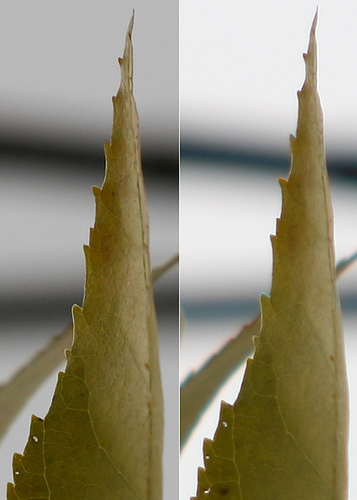October 18th, 2006
Lens versus Lens

Lens versus Lens, originally uploaded by LeggNet.
I was recently talking with a friend about photography and more specifically, lenses. He shoots with a Canon digital SLR and has a third party zoom lens. He is considering upgrading to a more expensive “L” (Canon’s pro line) lens and was asking me about the differences between top of the line lenses and the less expensive versions.
Since I happen to have two lenses of similar focal length that fall into the two categories we were talking about, I decided to do a little experiment. I set up my camera on a tripod and aimed it at a tree set against a bright white sky (I have found that shooting against a bright background will enhance any weaknesses in a lens). I then took nearly identical shots with each lens. Both of the sample images above were shot at a focal length of 200mm with an aperture f/5.6 and a shutter speed of 1/200. The image on the left was shot with a Canon 70-200 f/4L lens (non IS model) and the image on the right was shot with a Canon 100-300 f/4.5-5.6 lens. No post-processing was applied, other than cropping.
Notice how the image on the left has more detail in the veins and texture of the leaf. Also note the red fringe (known as chromatic aberration) on the edges of the leaf on the right (most notably on the background leaf). Other notable differences is the bluish colour on the background branches of the image on the right and the bokeh (out of focus background) being much smoother and more uniform on the left image.
The 70-200 f/4L is on the cheaper side of Canon’s L series yet still costs double that of their 100-300mm zoom. I think the results are worth the added expenditure.
Here are links to the unedited source images from each lens:
Canon 70-200 f/4L
Canon 100-300 f/4.5-5.6
Click here to view the above image at 100%
Labels: photography





